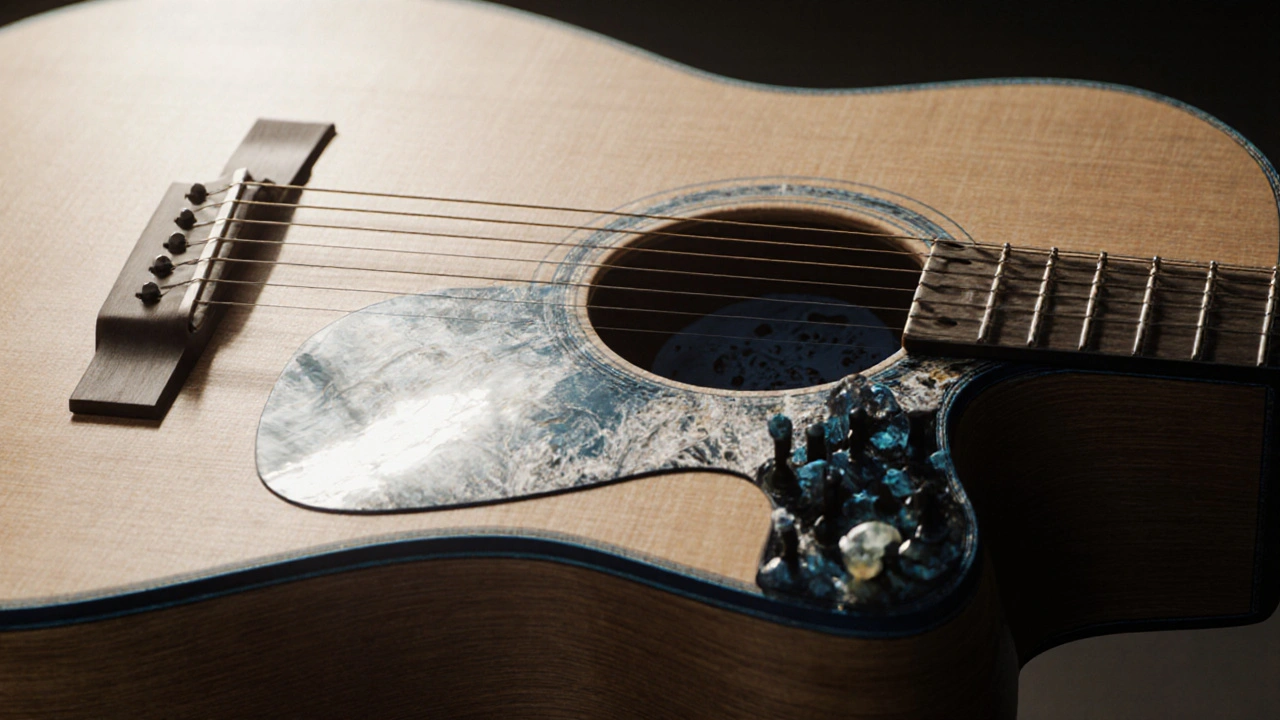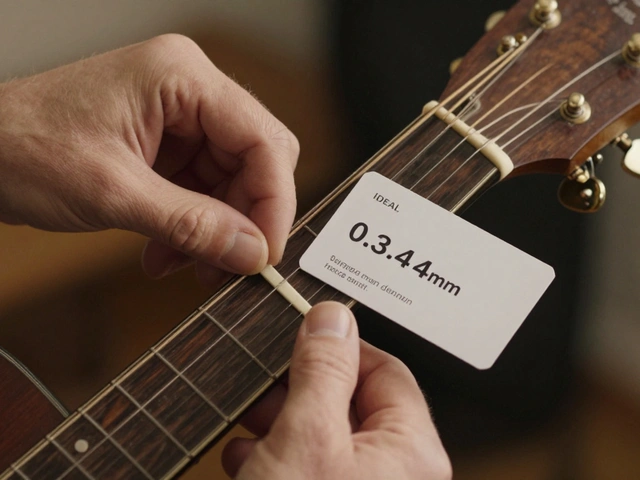Guitar Sustainability Calculator
How Your Guitar Choices Impact the Planet
Select materials and construction methods to see their environmental impact compared to traditional woods.
Environmental Impact Assessment
Plastic Saved
0 kg
CO2 Reduction
0 kg
Acoustic guitars haven’t changed much in appearance since the 1950s-curved body, round soundhole, six strings. But under the surface, the way they’re made has been quietly revolutionized. Today’s best-selling acoustic guitars aren’t just carved from old-growth spruce and rosewood. They’re built with engineered woods, 3D-printed braces, and even recycled ocean plastic. If you picked up a new Martin, Taylor, or Collings in 2025, you’re holding a product shaped more by data science than tradition.
Why the old ways aren’t enough anymore
For decades, luthiers relied on a few trusted tonewoods: Sitka spruce for tops, Brazilian rosewood for backs and sides. But those materials are harder to get. CITES restrictions on tropical hardwoods, climate change affecting forest growth, and decades of overharvesting made sourcing reliable wood expensive and unpredictable. By 2020, the price of high-grade Adirondack spruce had jumped 180% in just five years. Manufacturers couldn’t keep up with demand without changing how they built guitars.That’s when innovation kicked in-not to replace tradition, but to preserve it. Companies started asking: What if we could match the tone of old-growth wood without cutting down more trees?
Engineered tonewoods: science meets sound
The biggest breakthrough came with engineered tonewoods. These aren’t cheap plywood. They’re layered composites designed to mimic the density, stiffness, and resonance of rare hardwoods. Taylor’s Urban Ash and Martin’s High-Pressure Laminate (HPL) are two of the most successful examples. Both use sustainably harvested fast-growing woods like poplar and birch, compressed under extreme heat and pressure with bio-based resins.Independent testing by the University of Melbourne’s Acoustic Materials Lab in 2024 showed that Taylor’s Urban Ash produced harmonic response within 8% of traditional mahogany across the frequency spectrum. That’s not just close-it’s sonically indistinguishable to most players in blind tests.
Even more surprising? These materials are more stable. They don’t crack in dry climates. They don’t swell in humidity. A guitarist in Arizona or Singapore can play the same guitar year-round without worrying about the neck warping or the top splitting.
Carbon fiber and composite bodies
Then there’s carbon fiber. Once used only in high-end electric guitars and racing bikes, it’s now showing up in full acoustic bodies. Larrivée’s Carbon Fiber Series and Rainsong’s WS-1000 have been around for years, but in 2025, even mid-tier brands like Seagull and Godin are releasing carbon fiber models under $1,000.Carbon fiber doesn’t just make guitars durable-it makes them loud. Without the natural flex of wood, carbon fiber transmits string energy more efficiently. A carbon fiber guitar can project louder in a live setting without feedback. That’s why buskers in Sydney and street performers in Berlin are switching. One study from the Royal Conservatoire of Scotland found carbon fiber guitars produced 12% more SPL (sound pressure level) than comparable spruce-top acoustics at the same playing force.
And they’re tough. Drop one? It’ll bounce. Get caught in rain? No problem. Leave it in a hot car? Still in tune.

3D-printed bracing: precision over guesswork
Inside every acoustic guitar, the bracing holds the top in place and shapes the sound. For over a century, luthiers carved these braces by hand. Even with templates, there was variation-no two were identical. That meant two guitars of the same model could sound subtly different.Now, companies like Taylor and Collings use 3D-printed bracing made from ultra-light, high-strength thermoplastics. Each brace is designed using finite element analysis (FEA) software that simulates how vibrations travel through the wood. The result? Braces are optimized for specific tonal goals: brighter highs, deeper lows, or balanced midrange.
And because they’re printed, not carved, every brace is identical. Two guitars from the same batch? They’ll sound nearly the same. That’s huge for studio musicians who need consistency across multiple takes.
Sustainability isn’t a buzzword-it’s a requirement
In 2025, buyers don’t just ask, “Does it sound good?” They ask, “Where did the wood come from?”Companies are now using FSC-certified woods, reclaimed timber from demolished buildings, and even recycled materials. Martin’s Ecotone line uses 100% recycled plastic for pickguards and bridge pins. One manufacturer in Oregon even makes guitar bodies from ocean-bound plastic collected from the Pacific Gyre. Each guitar contains about 2.3 kilograms of recovered plastic-enough to prevent 1,200 water bottles from entering the ocean.
And it’s not just marketing. A 2024 survey of 1,200 acoustic guitar buyers in the U.S., Canada, and Australia showed that 68% were willing to pay up to 15% more for a guitar made with verified sustainable materials. That’s a market shift, not a trend.

AI-driven design and customization
Some brands are letting customers design their own guitars-with AI help. Taylor’s Custom Configurator lets you pick tonewood, bracing pattern, body shape, and even string gauge. Then, an algorithm predicts how your choices will affect tone, volume, and sustain based on 15 years of acoustic data from over 100,000 recorded guitars.You don’t need to be a luthier to use it. Just answer a few questions: “Do you play fingerstyle or strum hard?” “Do you prefer warm or bright?” The system then suggests combinations that match your playing style. It’s like having a master builder in your pocket.
Some players are skeptical. “Can a computer know what my guitar should sound like?” But feedback from early adopters is strong. One folk singer in Nashville used the configurator to build a guitar with a deeper bass response-something she couldn’t get from any stock model. She now uses it for every recording.
What this means for you
If you’re shopping for an acoustic guitar in 2025, you have more options than ever. You can get the warmth of spruce and rosewood-or the reliability of carbon fiber. You can choose a guitar made from recycled plastic or sustainably harvested maple. You can buy a factory-made instrument with laser-perfect bracing-or a hand-built one with traditional craftsmanship.The old divide-handmade vs. machine-made, wood vs. composite-is fading. The best guitars today aren’t defined by how they’re made, but by how they sound, feel, and hold up in real life.
Don’t assume a $2,000 guitar is better than a $600 one. Try both. Play them in different rooms. Record yourself. Let your ears decide-not the brand name or the wood label.
What’s next?
The next frontier? Self-tuning acoustic guitars with built-in piezoelectric sensors that adjust string tension in real time. Prototype models are already being tested by touring musicians. And some luthiers are experimenting with bioengineered wood grown in labs-trees shaped by DNA to have perfect grain density and resonance.For now, the most important innovation isn’t a new material or a new machine. It’s the mindset: great sound doesn’t require destroying forests. Great tone doesn’t require decades of tradition. It just requires smart thinking-and a willingness to try something new.






